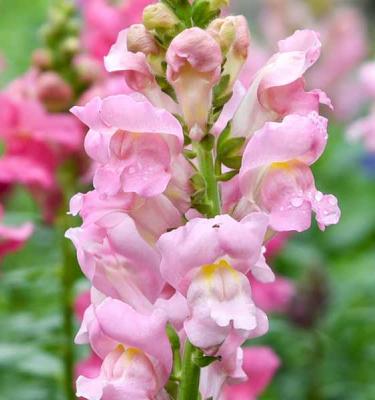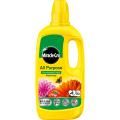

How to grow Snapdragons
Snapdragons, so called because of the dragon-like face shape of their flower and the way in which they can be pressed and then snap together, are also known as Antirrhinum majus. In fact, Antirrhinum comes from the latin for ‘like a snout’. They are reminiscent of vintage cottage gardens and have seen a resurgence as popular cut-and-come-again flowers.
Coming in a range of colours and sizes, Snapdragons bloom from June through to October on tall spire stems. The flowers run along the stem and open at the bottom first working their way up to the top. The flowers work really well in all sorts of gardening styles from informal cottage gardens through to more formal container gardening.
Snapdragons can be both annuals and perennials. We generally think of Snapdragons as shrubby half-hardy annuals, but they can also be tender perennials. This is because, if left to their own devices, they will self-seed for next year and are also able to manage some cold weather over the winter and possibly continue flowering into winter.
You can grow Snapdragons from seed at home or buy garden-ready plants when all risk of frost has passed.
Types of Snapdragons to grow
Snapdragons originated in southern Europe, more notably Spain and Italy. They have a light fragrance, with the real show coming from their spires of repeat flowers over several months.
Snapdragons are generally known as a mid-height plant, grown in the middle of the border. However, with around 40 species to choose from, Snapdragon plants do come in a range of heights from dwarf, intermediate and tall varieties:
- Dwarf - around 15cm tall - for example, ‘Tom Thumb’.
- Intermediate - around 30-40cm tall - for example, ‘Liberty’.
- Tall - up to 1m tall - for example, ‘Rocket’.
If you choose the tall Snapdragon varieties, you will need to stake, helping to keep them from toppling over.
Snapdragon hybrid varieties have continually evolved, for example, fused flowers, stronger scents, double blossom and trailing.
What you’ll need to grow Snapdragons
If you’re looking to grow Snapdragons from seed, here is what you need:
- Covered seed tray.
- A sunny and warm windowsill for best germination or a heated propagator.
- Peat-free seed compost.
- Watering can for light watering.
- A selection of 9cm pots for potting on the seedlings.
- Liquid feed for once the plants are in their final position.
- Stakes and twine for propping up tall varieties.
Snapdragons take around 21 days to grow from a seed to a seedling. They prefer a temperature of 16-18°C, so if you are potting seeds in a greenhouse, make sure it’s warm enough and keep the seed trays slightly on the dry side.
Snapdragon indoor planting season is usually February/March, but they can also be grown in late autumn for earlier flowering, protected in a greenhouse for example.
Snapdragon seeds are almost like dust so handle carefully and don’t sneeze!

Where to plant and place your Snapdragons
- In February/March, scatter thinly in a seed tray filled with good quality peat-free seed compost. Carefully handle the dust-like seeds.
- Cover with a light layer (approx 3mm) of compost and put on a warm windowsill or in a propagator/heated greenhouse to germinate. Water sparingly.
- Once germinated and big enough to handle carefully, pot on. Pot on Snapdragon seedlings into your 9cm pots once they are fuller and big enough to handle (approx 8 - 10 cm tall). Use potting on compost.
- When the risk of frosts has finished, around late May, plant out your Snapdragons.
Snapdragons prefer a sunny position, with good quality soil. Snapdragons won't flower well in shade, and will flower best in a sunny spot.
When planting out, be mindful of leaving enough space between the plants, and not planting them too tightly together, so ideally around 30cm apart. Dense planting can encourage mildew and other fungal growth due to a lack of airflow.
Depending on which size of Snapdragon plant you choose, place them in your bed accordingly with the taller varieties at the back through to dwarf at the front.
Snapdragons will also grow happily in pots in a sunny space but keep well watered and fed in the growing season with a liquid feed.
Caring and nurturing your Snapdragons
Snapdragon plants will grow best in full sun with good well-drained soil. Feed every couple of weeks in the growing season with a general multipurpose plant feed or a liquid seaweed feed. While establishing over the first couple of weeks, keep the soil moist. Thereafter Snapdragons like to be watered around their crown, with the soil being drier on the top 5cm or so.

How to deadhead Snapdragons
Once the Snapdragon plants are established, you can carry out some light clipping to create a bushier plant, as well as regular deadheading or cutting for filling indoor displays. Deadheading Snapdragons encourages more flowers to be produced. If you are using Snapdragons for cut flowers, there is no need for other deadheading.
How to propagate Snapdragons
If you want to try propagating Snapdragons, try one or all of the methods below:
1. Collecting Snapdragon seeds
Stop deadheading to allow the seedheads to form. Before the frosts come, collect the seed heads and either save to plant in the following February or scatter over the soil and leave to over winter in-situ.
2. From a cutting
About a month or so before autumn/frosts set in, take a cutting from your plant, dip in a rooting hormone powder and gently place in warm, damp soil. To take the Snapdragon cutting, snip off approx 2-5cm of the stem, just above a leaf node.
If your Snapdragons plants have started to die down at the end of the summer, cut them back by about a third and they may flower again. If you don’t want them to have the option of self-seeding, pull out the whole plant before the seed heads appear.
Common pests and diseases with Snapdragons
What are the yellow spots on the leaves of my Snapdragon plants?
One of the most common diseases associated with Snapdragons is Antirrhinum Rust. Generally appearing from late spring and into autumn and more often when the weather is wetter. It is caused by airborne fungus spores that cause pale yellow spots on the upper surface of the leaf, which then turn brown. The affected leaves will shrivel and the plant will look less vigorous. Snapdragon Rust can also affect the stems, causing bumps and blemishes.
To get rid of Snapdragon rust, there are two options:
- Remove the leaves and affected plants and dispose of them, trying to make sure all the infected parts are off the soil.
- Use a fungicide such as FungusClear.
What insects feed on Snapdragon plants?
Like most flowering plants in the UK, there are several insects that feed on Snapdragons. These insects are generally a type of aphid, whitefly or mealybug and they cause shrivelled leaves and flowers.
Check on the underside of the leaves and, if you spot unwanted insects on the back, give the leaves a blast from your hosepipe over the following few days.
Frequently asked questions about Snapdragons
Can Snapdragons survive winter?
Snapdragons can sometimes survive the winter as long as the weather is not too harsh. The plants manage with cold weather, but may struggle in frosts and snow. If you have grown Snapdragons in pots, move them into a greenhouse or more sheltered spot to give them the best chance of surviving the winter.
Are Snapdragons cut-and-come-again flowers?
Snapdragons are great cut-and-come-again flowers. They are a popular choice for cut flower gardens due to the length of time they flower, range of sizes and huge selection of colours. Cutting the flowers encourages new flowers to grow.
Do Snapdragons come back every year?
Plants that come back every year are called Perennials and those that last only a year are known as Annuals. Snapdragons fall into both categories. Snapdragons are generally sown around January/February and flower in June through to October.
If you leave the seed heads on they will self-seed for flowering the next year. They are also able to manage in cold weather. Cutting back the Snapdragon plants in the autumn and leaving in situ can also be a way to encourage Snapdragons to flower the following year.
A Snapdragon plant generally lasts about two years before it fully dies back.
Do Snapdragons do well in pots?
Yes, Snapdragons grow equally well in containers and pots as in beds. Make sure your pots are big enough to support the size of the Snapdragon you choose, and use a good peat-free compost.
Key features of Snapdragons
| Botanical Name | Antirrhinum majus |
|---|---|
| Plant Type | Bushy annuals or perennials |
| Family | Plantaginaceae |
| Light Exposure | Full sun |
| Soil pH | Neutral |
| Flowering Time | June to October |
| Flower Colour | All colour ranges apart from blue |




